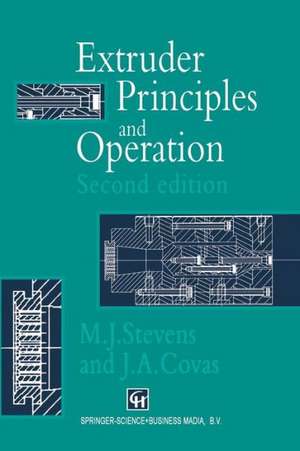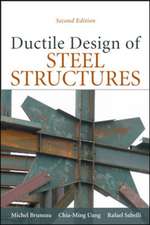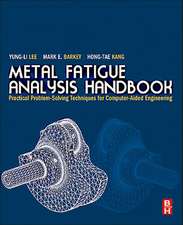Extruder Principles and Operation
Autor M.J. Stevens, J.A. Covasen Limba Engleză Paperback – 26 oct 2012
| Toate formatele și edițiile | Preț | Express |
|---|---|---|
| Paperback (1) | 1221.51 lei 6-8 săpt. | |
| SPRINGER NETHERLANDS – 26 oct 2012 | 1221.51 lei 6-8 săpt. | |
| Hardback (1) | 1224.51 lei 6-8 săpt. | |
| SPRINGER NETHERLANDS – 31 oct 1995 | 1224.51 lei 6-8 săpt. |
Preț: 1221.51 lei
Preț vechi: 1489.65 lei
-18% Nou
Puncte Express: 1832
Preț estimativ în valută:
233.74€ • 249.94$ • 194.88£
233.74€ • 249.94$ • 194.88£
Carte tipărită la comandă
Livrare economică 18 aprilie-02 mai
Preluare comenzi: 021 569.72.76
Specificații
ISBN-13: 9789401042475
ISBN-10: 9401042470
Pagini: 512
Ilustrații: XI, 494 p.
Dimensiuni: 155 x 235 x 27 mm
Greutate: 0.71 kg
Ediția:Softcover reprint of the original 2nd ed. 1995
Editura: SPRINGER NETHERLANDS
Colecția Springer
Locul publicării:Dordrecht, Netherlands
ISBN-10: 9401042470
Pagini: 512
Ilustrații: XI, 494 p.
Dimensiuni: 155 x 235 x 27 mm
Greutate: 0.71 kg
Ediția:Softcover reprint of the original 2nd ed. 1995
Editura: SPRINGER NETHERLANDS
Colecția Springer
Locul publicării:Dordrecht, Netherlands
Public țintă
ResearchCuprins
1 Introduction.- 1.1 Scope and limitations.- 1.2 Method.- 2 Practical extrusion processes and their requirements.- 2.1 Shaping processes and their requirements.- 2.2 Other applications and their requirements.- 3 Flow behaviour relevant to extrusion.- 3.1 Viscosity.- 3.2 Shear flow.- 3.3 Extensional flow.- 3.4 Elastic effects.- 3.5 Measurement of viscosity and elasticity.- 4 Thermal and energy properties in processing.- 4.1 Thermal properties.- 4.2 Thermal conduction.- 4.3 Non-isothermal flow and heat transfer.- 4.4 Mixing.- 5 Extrusion dies.- 5.1 Introduction.- 5.2 Factors influencing the performance of an extrusion die.- 5.3 Extrusion dies for some profiles.- 5.4 General principles of die design.- 5.5 Specific aspects of die design.- 5.6 Operational strategies for problem-solving.- 6 Principles of melt flow in single-screw extruders.- 6.1 Functions of the extruder.- 6.2 Derivation of flow equation.- 6.3 Leakage flow.- 6.4 Output equations and longitudinal pressure profiles for common screw types.- 6.5 Graphical representation of output for screw/die combinations, including venting.- 6.6 Output corrections.- 6.7 Pseudoplastic flow.- 6.8 Non-isothermal flow.- 7 Solids conveying and melting in single-screw extruders.- 7.1 The relevance of solids conveying and melting.- 7.2 Phenomenological description of solids conveying and melting.- 7.3 Theoretical analysis.- 8 Principles of energy balance.- 8.1 Energy balance and efficiency.- 8.2 Power consumption in the screw: Newtonian isothermal case.- 8.3 Pseudoplastic isothermal approximation.- 8.4 Power in non-isothermal flow.- 8.5 Effect of variables on energy balance.- 9 Operation of single-screw extruders.- 9.1 Overall performance of the screw.- 9.2 Effects of controlled variables.- 9.3 Polymer properties.- 9.4 Screw design.-9.5 Operational strategies.- 10 Twin-screw extruders.- 10.1 Non-intermeshing screws.- 10.2 Partial intermeshing.- 10.3 Full intermeshing: counterrotation.- 10.4 Full intermeshing: corotation.- 10.5 Comparison of machine types.- 11 Extruder operation as part of a total process.- 11.1 Quality.- 11.2 Stability.- 11.3 Shear history.- 11.4 Control.- 11.5 Scale-up.- 12 Practical extruder operation.- 12.1 Steady operation.- 12.2 Colour and grade changing.- 12.3 Start-up and shut-down.- 12.4 Dismantling and cleaning.- 12.5 Waste recovery.- 13 Application to the individual machine.- Appendices.- A Properties of polymers for heat and flow.- B Derivations of flow and pressure.- B.l Alternative derivation of flow equation.- B.2 Estimation of leakage flows.- B.3 Longitudinal pressure profiles.- B.4 Pressure gradients in a stepped screw.- C Energy consumption and energy balance.- C.l Experimental determination of energy balance.- C.2 Derivation of power absorbed in screw.- C.3 Heat flows in melt pumping section.- C.4 Distribution of shear heating and transverse circulation.- C.5 Temperature variation in the flight clearance.- D Stability of melt pumping section.- E List of tables.- References.









